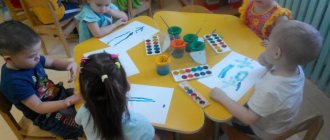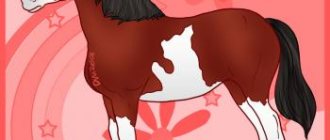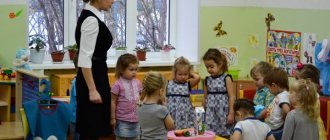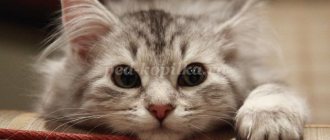Preview:
Summary of continuous educational activities in drawing in the second junior group on the topic: “Pets”
- learn to depict round objects with one movement of the hand;
-continue to introduce the main colors (yellow-sun, green-grass, blue-flower, pink);
- develop fine motor skills of the hands, coordination of hand movements; sense of color, shape, size; develop aesthetic perception, speech and thinking.
-continue to develop the ability to hold a brush correctly.
- to cultivate a caring attitude towards things, neatness, and a friendly attitude towards each other.
a) demonstration - a soft toy pig..
b) handouts - ½ landscape sheet, gouache in pink, green, blue, yellow and black, napkins, cups of water, brushes.
Form of implementation: joint activity.
Methodological techniques: organizational aspect, practical exercises, physical education, breathing exercise, finger gymnastics, summing up, encouraging children.
The teacher tells the children that he has a gift for them and asks them to guess the riddle:
Nose with a wet snout Tail with a curled hook Pink back Sleeping in a pen...
Educator: That's right. Guys, how many of you remember where the pig lives?
Educator: does the pig have friends on the farm?
Children: yes! Dog, cat, horse, cow, goat.
Kitties live next to humans (they make a roof over their heads with their hands, move their hands like cats)
And the dogs faithfully guard their home (show ears above their heads)
Cows give us: meat, milk, (show horns above their head)
Goats and sheep jump easily (jumping, hands on the belt)
It’s hard for fat piglets to walk (hands on the belt, turns around)
It’s better to be a fast horse. (fists in front of you, beat with one leg like a hoof)
Educator: Let's draw our pig together..
- Kids love it very much
— Paints and pencils.
- We will draw with them
- What? Can you guess? (pig)
- Guys, today we will have pigs. On the tables in front of you are pieces of paper with a circle drawn on them. Let's finish drawing the heels, ears, paws and eyes so that we get a funny pig.
But first, let's prepare our fingers.
Place the palm of your left hand with its edge on the table, like a closed gate. The fingers of the right hand are piglets. The palm lies on the table, the fingers are rounded.
Five cheerful piglets are standing behind the gate.
These piglets are waiting for someone to bring them food.
Place the fingers of your right hand between the fingers of your left (into the “slits”)
Five cheerful piglets are looking into the cracks from below.
They run here and there: “Where is the delicious food?”
Move the fingers of your right hand
Five cheerful piglets are knocking on the door with their hooves, knocking with the fingers of the right hand on the palm of the left (gate).
Suddenly this door opened:
Move the palm of your left hand back a little (the gate opens).
“You can run out now!”
The fingers of the right hand (piglets) run across the table.
Five cheerful piglets squeal loudly and joyfully:
“Here is a trough, yes, yes, yes, and there is delicious food in it!”
The left hand is a trough. Turn your palm over to the back side, making a “bucket” hand. Using the fingers of your right hand (piglets), scrape along the palm of your left (trough).
Five cheerful piglets are very hungry
And at the same moment with my head in the trough,
Clap with a swing of the right hand over the palm of the left
The teacher shows the children how to hold the brush correctly (with three fingers, just above the iron tip, making sure that the children are sitting upright. First, the children perform circular movements in the air, then carefully dip the brush first into water, then into paint. Excess paint is squeezed out on the edge of the jar The brush is washed from paint and wiped with a napkin.
The teacher puts all the children's drawings on display, analyzes the children's work, praises the children, and, if necessary, helps a child who has difficulty completing a task.
MAGAZINE Preschooler.RF
Notes on drawing for children of the 2nd junior group Topic: “Puppy”Target:
- Forming the ability of children to paint with a hard brush using the poking method, mastering the color palette (orange, brown).
Tasks:
Educational
- To develop children’s ability to paint with a hard brush using the poking method.
- Improve the ability to hold a brush correctly while working.
- Master the color palette (orange, brown)
- Strengthen the ability to draw with crumpled paper and select colors, complement small missing details using plasticine.
- Enrich children's vocabulary
Developmental
- Develop creative abilities and aesthetic perception.
Educational
- Cultivate a kind attitude towards pets.
- Cultivate activity and the desire to complete work to the end.
- Continue to encourage independence and creativity.
Correctional
- Develop fine motor skills of hands
Integration of educational areas:
- cognition
- communication
- artistic creativity
- socialization
- music
- health.
Materials:
Half a landscape sheet with a drawn outline of a puppy (for each child).
Brown, orange gouache, hard brush.
A small sheet of paper (palette) for each child to check the poke and the correctness of the chosen color, jars for brushes, plasticine lumps of different colors for the eyes (2 pcs.) and black for the nose (1 pc.), fabric napkins.
Two paper kennels (orange and brown) for the didactic game “Each dog has its own house .
Puppy caps for dynamic pause.
Demo material:
Outline of a puppy on a sheet of paper, film on a laptop with a picture of a puppy and a dog.
Preliminary work:
Looking at illustrations, postcards, paintings depicting dogs, playing with a toy dog, reading E. Charushin's stories about Tomka, watching the dog on a walk.
Progress of the lesson
Children enter the hall. Educator: - I’m very glad to see you, Hello! Draws children's attention to guests.
Children say greeting:
Hello hands - clap, clap! Hello legs - top, top! We need to say hello to each other! Hello dear guests!
We will draw!
The children turn to the teacher.
Voss: Guys, I’ll tell you a story about Grandma Arina (the teacher puts on an apron and scarf), who lived in a very beautiful, noisy yard and had many friendly, kind and funny pets.
The leader asks the children a question: “Do you like pets?”
Children: - Yes.
Then I invite you to take a walk through this wonderful yard and get to know my pets.
The voices of pets are heard. She lived with Ryaba the Hen, Rogatushka the Burenushka, a purring cat, a yoke horse and three cheerful little pigs.
Oh, guys, look, whose house is this? I wonder who lives in it?
Now I'll ring the bell. The sun calls (the monitor turns on), a dog and a puppy appear. A problematic situation is created: “How to help a puppy find friends ,” because he has no one to play with.
- Children, we need to help the puppy, draw friends. Shall we help? (Yes).
-I will teach you how to draw beautiful puppies using the poking method. Come to me. And the puppy will watch us how children can draw beautifully.
(Children approach the easel and stand in a semicircle.)
Educator: - You know how to paint with a soft brush, but today you will learn to paint with a hard brush. Try with your finger to see how hard the brush is... The brush bites...
Teacher (shows): - I put paint on a brush and paint with a poke: first I’ll paint the face along the contour, it’s round, and now in the middle. Then - the body, legs, tail. I’ll rinse the brush in water, dry it on a napkin and put it in a glass. And we will draw the grass under the paws in a way that is already familiar to you - with crumpled paper, what color? (green).
-Right. I put paint on a crumpled leaf and paint grass.
And I’ll make the nose and eyes out of plasticine, look. I take a small ball and press it to the muzzle with my finger, and now another one. Here are the eyes. And now the nose. Look how the dog turned out! Fluffy, soft, funny.
-Tell me, which brush will you use to paint the puppy’s fur? (hard).
-Where should you first draw the fur on the head or body?
Now sit down at the tables. Now we will do a little warm-up. Take a hard brush in your hands. Begin:
We hold the brush like this: (Hand on the elbow. Hold the brush above its metal part). It's difficult? No, it's nothing! The tassel poked and the heel clicked. (Move your hand along the text).
One poke, two pokes. And then, then, then (Circular movements of the hand). The brush runs around. Spun like a top.
After a poke comes a poke. (Children poke on the table with a dry brush).
- Well done, put some paint on a dry brush and get to work.
Independent work of children.
The teacher controls the drawing process and helps the children if necessary.
Physical education minute.
Friendly puppies run merrily, singing cheerfully in their ringing voices: “Woof - woof - woof!” And then the front legs raise,
And they happily wag their tails at each other. They ran away...... They played out (circling behind their tail). And everyone quickly gathered to see me (the teacher hugs the children) -2 times.
(Children perform movements in accordance with the text).
Voss: - Guys, we need to finish our work, and to do this, go to your tables. What haven't you done for the dogs yet?
Children answer: - Eyes and nose.
Voss: - That's right. Let's make eyes and a nose from plasticine. Take the small blue balls, these are the eyes, and place them on the puppy’s face and press with your finger.
-Well done! Ready!
-What else do we have left? Nose.
-Let's take a big black lump and make a nose for the dog.
Our puppies are ready.
-Now let’s draw the grass with crumpled paper.
Didactic game “Let’s put the puppy in the house .
Educator: - Children, take your work in your hands and come to me. In front of you are houses for puppies. We need to put brown puppies in a brown house, and orange (red) ones in an orange house. (Children place their puppies next to the houses of the corresponding color).
An analysis of children's work is carried out.
Educator: - Guys, what funny, wonderful puppies you have turned out to be: fluffy, cheerful! You tried, you worked carefully. Now Shustrik will have many, many friends!
A puppy is heard barking.
The boy turns on the laptop and a puppy appears, who is very happy and says to the children “thank you very much!”
Educator: - guys, let's remember what we did today? (Children's answers) What brush did you paint with? (hard). Well done! Today we tried, did a good deed for the puppy, and I’m giving you each a friend (the teacher gives out puppies).
Voss: - And now we need to return to the children's room. garden.
-Eyes close. The kids are smiling. The eyes open. They return to the kindergarten.
Summary of direct educational activities in artistic creativity Topic: “Puppy” 2nd junior group MBDOU No. 144 D/S “Sun” Educator high. sq. categories Kalacheva E.V.
| Next > |
On the topic: methodological developments, presentations and notes
Goal: to form an idea of the family and its members, of the friendly, friendly relationships of relatives. Objectives: Educational: - naming family members, active use of generalizing words.
Goal: to teach how to depict round objects with one movement of the hand.
Summary of continuous educational activities in drawing in the second junior group “Boat”.
Goal: development of children's creative abilities. Objectives: consolidate children's knowledge about the wild animal - the crocodile; form creative thinking, sustainable interest in artistic activities; perfect.
Summary of continuous educational activities in drawing in the second junior group, adapted for carrying out under quarantine conditions. “Apples for bunnies” Prepared by Kireychikova M.Yu.Ts.
Summary of continuous educational activities in drawing in the second junior group, adapted for carrying out under quarantine conditions. “Apples for bunnies.”
Development of productive visual activity: the ability to draw with cotton swabs, using gouache.
Source
Progress of the lesson.
Educator: Guys, listen to the nursery rhyme and you will find out who came to visit us.
Educator: That's right, bunny!
There is a knock on the door.
Educator: I wonder who else came to us?
He brings in the fox: the teacher puts a bi-ba-bo doll on his hand and says on her behalf: “Hello! Whoa, who do I see (a hare, I want to play hide and seek with you. I will turn my back, and you hide."
Educator: Guys, let's help the bunny, otherwise the fox will catch him and eat him! Shall we help the bunny?
Educator: What can we do to save the bunny?
Children's answers. The teacher praises and selects the most successful and inventive answers.
Educator: It’s winter outside, everything is covered with white snow . And the little hares in their gray fur coat stand out against the white snow .
Educator: What color is the fur of bunnies in winter?
Educator: Correct. A white fur coat is needed so that the hare is not visible in the snow . What other kind of fur do rabbits have?
Children: She is fluffy and soft.
Educator: Well done! In order for our bunnies to have the same fur, you need to pick up a little white gouache with a dry, hard brush, and, holding the brush vertically, make pokes on top inside the outline.
drawing methods .
Independent activity of children.
At the end of the lesson, the results are summed up .
Educator: Well done! Look what beautiful white and fluffy bunnies you have made! Well, little fox, you can look for bunnies!
Fox (addressing the children)
: “Now I’ll quickly find the hares.
(Looks at the children's work)
. Where are they? Well, again I couldn’t catch the rabbits. "
Educator: “Well done, guys! They helped the bunnies well.”
Photo report on a drawing lesson with children aged 5–6 years on the topic “Hare in the Snow” Our bunnies are fashionistas, They have changed their frock coats: Nowadays the hares are white, Even though they were grey. In autumn it is easier for gray people to live among gray nature, and in winter it is calmer.
Abstract of an integrated GCD on the topic “Wild animals. Hare" (early age) Purpose: Introducing children to wild animals. Objectives: To introduce children to wild animals; Teach children to understand the question and answer it;
Summary of educational activities for children of the second junior group “Let's help the squirrel. Wild animals" Problems. To consolidate children’s ideas about autumn, its characteristic features, and autumn natural phenomena. Reinforce the concept of “wild animals”.
Abstract of the GCD in the second junior group “Wild animals and their young” Purpose: to summarize children’s ideas about wild animals and their young. Objectives: Educational: Consolidating ideas about features.
Source
On the topic: methodological developments, presentations and notes
Summary of an integrated lesson on visual arts (non-traditional drawing techniques) and music on the topic: “Cockerel”.
Summary of educational activities on visual activities (drawing) for children of the younger group “Rain, more often, drip-drip-drip!” using an unconventional technique of drawing with cotton swabs.
Goals: - to form in children an idea of the characteristic features of the image of a rooster and chickens based on the visual and expressive means of poetic words, music and visual arts.
A bear comes to visit the children and the children introduce him to their city, Zavodoukovsk.
Animals are always very interesting for children. They love to draw them, but it is still difficult for small children to draw animals and the technique of painting with a dry brush “Poke” comes to their aid.
Program content: Teach children to draw in an unconventional way - with a cotton swab; Expand children's understanding of plants and animals in the spring; Develop children's skills in applying stains unconventionally.
Form friendly relations in the team, contribute to the accumulation of experience of friendly relations, a negative attitude towards rudeness. Develop children's spoken language and enrich their vocabulary.
Source
Progress of the lesson:
Educator: Guys, today I suggest you go to a clearing where forest animals . Would you like to go with me?
Educator: Well then, grab your hands and follow me.
Educator: guys, look what this is? It looks like these are someone's tracks , but where are the forest animals ? Guys, maybe you know?
(children's opinions are listened to)
.
Educator: It’s possible that they got scared of us and ran away. Let's find them, and we'll look for them by tracks . First, you need to guess who has what marks ? (I help the children guess who has what marks ,
(we found a squirrel in a tree, a fox in a hole, a bunny behind a bush)
.
Educator: clever guys, we found forest dwellers , now let's invite them to visit us (sit down at the tables)
.
Educator: guys, since we invited a bunny, a squirrel and a fox to visit, let's please them and draw pictures for them. (children draw animal tracks with their fingers )
.
Educator: Well done guys, you tried very hard and the drawings turned out beautiful, I think the forest animals will no longer be afraid of us and will come to visit us more than once (children give their drawings)
.
Educator: Kropotova E. G.
Presentation of a group on non-traditional drawing techniques At the age of ten, at seven, and at five All children love to draw. And everyone will boldly draw everything that interests him. Everything is of interest: Distant.
The influence of non-traditional drawing methods on children's positive emotions. From work experience (abstracts) Theses of accumulation of experience in non-traditional drawing techniques for preschoolers of the teacher of MBDOU kindergarten No. 29 Lena Sagitovna Asfatullina.
Source
Notes on drawing in the first junior group “Wild Animals. Hedgehog"
Inna Rybkina
Notes on drawing in the first junior group “Wild Animals. Hedgehog"
Summary of GCD for drawing in the first junior group
Goal: Creating the image of a hedgehog in collaboration with the teacher: completing the “needles”
- from short straight lines.
Learn to use a pencil (wax crayon, draw straight lines from top to bottom.
Develop fine motor skills of the hands, develop aesthetic perception. Develop a sense of rhythm and color.
Foster independence in work and a desire to help.
Equipment: Hedgehog toy, sheets of paper depicting a hedgehog without needles, black pencils.
— "Communication"
Activate the words “needles and thorns” in children’s speech. Answer the teacher's questions.
— "Cognition"
Introduce children to
the animal hedgehog (what it is, where it lives)
.





